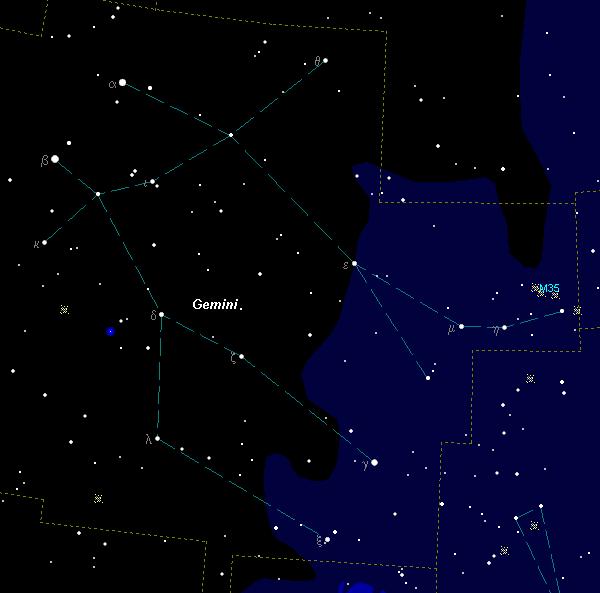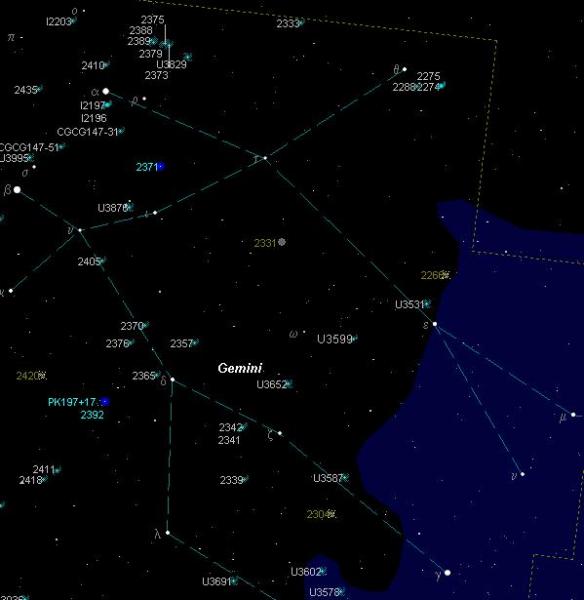Looking Up To The Twins
As dusk settles, the famous twins of the constellation Gemini come out to play. Castor on the top right and Pollux, the bottom left, represent the twin’s heads and helps orient you to the rest of the asterism. At a distance of close to 50 light-years (ly), Castor measures about half the diameter of the Sun and is a true system in itself – comprising of three spectroscopic double stars, orbiting each other. For a challenge move your scope a lunar width (30 arc minutes) below Castor till you come to a couple of 14th magnitude galaxies designated as IC2196 and IC2197.
On the other hand, Pollux at 34 ly away and is actually the brighter of the two iconic stars by about a half magnitude. But for some reason, Bayer proclaimed Castor as the Alpha star. It was announced in 2006 that Pollux has an extrasolar planet orbiting it. Although Castor and Pollux might look the same, they have completely different lives.

A total of 70 NGC objects reside within Gemini’s borders, mostly galaxies hovering the 12th to 14th magnitude range, along with a couple of open clusters and a handful of planetary nebulae. Speaking of planetaries, be sure to locate NGC 2392 - the Eskimo Nebula. At moderate power, the 10th magnitude central O type star is evident as well as the nebula’s beautiful bluish-green colour. Some times called the Clown Face Nebula, NGC 2392 is located some 3,000 ly from us.
Another interesting looking planetary is NGC 2371. Just like galaxies, planetaries take on different shapes and NGC 2371 is no different. Commonly known as the Gemini Nebula, NGC 2371 looks like a couple of teardrops when view in large telescopes and has a faint magnitude 14.8 central star.
Switching gears for a moment look for the open cluster NGC 2395. At magnitude 8.0 this star group measures about 12 arc minutes across and has a line of stars of all the same brightness. Another feature is the central bright sun. Another of the few open clusters associated with Gemini is NGC 2420. Pretty well the same brightness as NGC 2395 with four brighter stars that form a square around this dense cluster.

While in the area, you can try for UGC 3873. Locate only nineteen arc minutes south of the Eskimo this faint spiral galaxy lists as magnitude 14.6 and can give you a bit of trouble. Snuggled between the Lambda and Zeta stars is NGC 2339. It is a nicely defined face-on galaxy that shows up better with photography and of course large telescopes.
When it comes to open clusters, M35 takes the cake. At only 250 ly from us, it is a lovely naked eye object under dark skies and even registers on a one minute guided wide-angle exposure with a digital camera. However, very low power is the way you want to go. M35 is close to the size of the full moon. But once you have locked on M35, look for the fainter NGC 2158 just south and west of the cluster. NGC 2158 is estimated to be six times further than M35.
| Object | Type | Magnitude | R.A. | Dec. |
|---|---|---|---|---|
| IC 2196 | Galaxy | 14.0 | 7h 34m | +31° 24' |
| M35 | Dense Open Cluster | 5.1 | 6h 8m | +24° 20' |
| NGC 2339 | Round Galaxy | 11.6 | 7h 8m | +18° 47' |
| NGC 2371 | Planetary Nebula | 13.1 | 7h 25m | +29° 29' |
| NGC 2392 | Planetary Nebula | 10.0 | 7h 29m | +20° 55' |
| NGC 2395 | Open Cluster | 8.0 | 7h 27m | +13° 35' |
| NGC 2420 | Open Cluster | 8.3 | 7h 38m | +21° 34' |
| UGC 3873 | Galaxy | 14.5 | 7h 28m | +20° 35' |
The mighty planet Jupiter is slowly moving its way up the dark sky. But for now, it is glimpsed low in the southeast when the morning sky lightens. Venus gave a spectacular show as it set in the western sky last month. As it did, its angular size really increased. Venus now graces the morning sky. Be sure to keep following Saturn as its rings slowly tilt and move to the moment of invisibility in September of this year
A few events have been scheduled for this year’s International Year of Astronomy (IYA). From April 2nd to 5th will be a four-day marathon called the “100 hours of astronomy”. Many RASC Centres, as well as clubs around the world, will be conducting nightly star parties as well as daily solar observing. Let’s hope the weather holds for these festivities.
Till next month, clear skies everyone.
